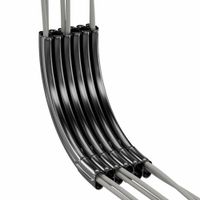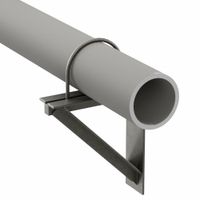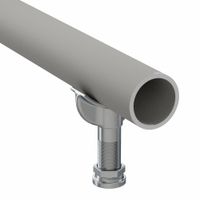Call +(254) 703 030 000 / 751 483 999 / 721 704 777
- Home
- Pipe Hose Tube Fittings
- Tube Pipe Routing Clamps Supports Hangers
- Surface Mount Tube Pipe Supports
.....Read More
Frequently Asked Questions
What are surface-mount tube and pipe supports used for?
Surface-mount tube and pipe supports are used to secure and stabilize pipes and tubes in various applications, ensuring they remain in place and function effectively. These supports are crucial in both industrial and residential settings, providing several key benefits:
1. **Stability and Support**: They prevent pipes from sagging or moving, which can lead to leaks, damage, or inefficient operation. By maintaining the correct alignment, they ensure optimal flow and function.
2. **Vibration Reduction**: In systems where pipes carry fluids or gases, vibrations can occur due to flow dynamics or external factors. Surface-mount supports help dampen these vibrations, reducing noise and preventing wear and tear on the pipes and connected equipment.
3. **Thermal Expansion Accommodation**: Pipes can expand or contract with temperature changes. Surface-mount supports allow for this movement, preventing stress and potential damage to the piping system.
4. **Corrosion Prevention**: By keeping pipes elevated and away from potentially corrosive surfaces, these supports help extend the lifespan of the piping system.
5. **Ease of Installation and Maintenance**: Surface-mount supports are relatively easy to install and adjust, making them convenient for both initial setup and ongoing maintenance. They allow for quick access to pipes for inspection or repair.
6. **Space Optimization**: In environments where space is limited, these supports help organize and route pipes efficiently, maximizing available space and ensuring a tidy setup.
7. **Safety**: Properly supported pipes reduce the risk of accidents or failures, contributing to a safer working or living environment.
Overall, surface-mount tube and pipe supports are essential components in ensuring the reliability, efficiency, and safety of piping systems across various industries.
How do tube and pipe rollers accommodate temperature changes?
Tube and pipe rollers accommodate temperature changes primarily through their design and material selection, which allow for thermal expansion and contraction without causing damage or misalignment. Here are the key ways they achieve this:
1. **Material Selection**: Rollers are often made from materials with low thermal expansion coefficients, such as certain metals or composites, to minimize dimensional changes with temperature fluctuations.
2. **Design Flexibility**: The design of the rollers includes features that allow for slight movements. This can include adjustable components or the use of flexible couplings that can absorb expansion and contraction.
3. **Clearance and Tolerances**: Rollers are designed with specific clearances and tolerances that account for expected thermal expansion. This ensures that even when the material expands, it does not lead to jamming or excessive friction.
4. **Thermal Compensation Devices**: Some systems incorporate thermal compensation devices, such as expansion joints or sliding supports, which allow the pipes to expand and contract without imposing stress on the rollers.
5. **Lubrication**: Proper lubrication reduces friction and wear, accommodating slight movements due to thermal changes and ensuring smooth operation.
6. **Regular Maintenance**: Regular inspection and maintenance ensure that any thermal effects are identified early and addressed, preventing long-term damage.
7. **Environmental Control**: In some cases, the environment around the rollers is controlled to minimize temperature fluctuations, such as through insulation or climate control systems.
By integrating these strategies, tube and pipe rollers effectively manage the challenges posed by temperature changes, ensuring reliable and efficient operation in various industrial applications.
What is the purpose of support stanchions in piping systems?
Support stanchions in piping systems serve several critical purposes to ensure the safe and efficient operation of the system. Primarily, they provide structural support to the pipes, preventing sagging, bending, or excessive movement that could lead to mechanical failure or leaks. By maintaining the proper alignment and elevation of the pipes, stanchions help in distributing the weight of the pipes and the fluid they carry evenly, reducing stress on the pipe material and joints.
Additionally, support stanchions help in absorbing and dampening vibrations caused by fluid flow, pumps, or external factors like seismic activity. This vibration control is crucial in preventing fatigue and potential damage to the piping system over time. Stanchions also play a role in accommodating thermal expansion and contraction of pipes due to temperature changes. By allowing controlled movement, they prevent undue stress and deformation that could compromise the integrity of the system.
In industrial settings, support stanchions contribute to safety by ensuring that pipes are securely anchored and do not pose a hazard to personnel or equipment. They also facilitate maintenance and inspection activities by keeping pipes accessible and organized. Furthermore, stanchions can be designed to meet specific environmental and operational conditions, such as resistance to corrosion, chemical exposure, or extreme temperatures, enhancing the durability and longevity of the piping system.
Overall, support stanchions are essential components in piping systems, providing stability, safety, and functionality, while also helping to extend the lifespan of the system and reduce maintenance costs.
How do support blocks help in maintaining pipe systems?
Support blocks play a crucial role in maintaining pipe systems by providing stability, reducing stress, and ensuring proper alignment. They help distribute the weight of the pipes evenly, preventing sagging and potential damage due to gravitational forces. By supporting the pipes at regular intervals, support blocks minimize the risk of bending or deformation, which can lead to leaks or system failure.
These blocks also absorb vibrations and thermal expansion, which are common in pipe systems due to temperature fluctuations and fluid dynamics. By accommodating these movements, support blocks prevent undue stress on the joints and connections, thereby extending the lifespan of the system.
Additionally, support blocks help maintain the correct slope and alignment of pipes, which is essential for the efficient flow of fluids. Proper alignment ensures that there are no blockages or backflow issues, which can compromise the system's functionality.
In environments where pipes are exposed to corrosive elements or harsh conditions, support blocks can be made from materials that resist corrosion, thereby protecting the pipes and enhancing the system's durability.
Overall, support blocks are integral to the structural integrity and operational efficiency of pipe systems, reducing maintenance needs and preventing costly repairs.
Where can support brackets be mounted for pipe runs?
Support brackets for pipe runs can be mounted in several locations to ensure stability and proper alignment of the piping system. These locations include:
1. **Ceilings**: Brackets can be attached to ceiling joists or beams, providing overhead support for horizontal pipe runs. This is common in basements, industrial settings, and commercial buildings.
2. **Walls**: Wall-mounted brackets are used to secure pipes running parallel or perpendicular to walls. They can be attached to wall studs or masonry using appropriate anchors.
3. **Floors**: For vertical pipe runs, brackets can be mounted on the floor, especially at the base of the pipe, to provide stability and prevent movement.
4. **Structural Steel**: In industrial environments, support brackets can be mounted on existing structural steel frameworks, such as I-beams or columns, using clamps or welded connections.
5. **Racks and Frames**: Custom-built racks or frames can be used to support multiple pipes in parallel runs, often seen in mechanical rooms or utility corridors.
6. **Trapeze Hangers**: These are used to support multiple pipes from a single set of brackets, typically suspended from the ceiling or structural elements.
7. **Concrete Surfaces**: Brackets can be mounted on concrete walls or ceilings using expansion anchors or concrete screws.
8. **Pipe Stands**: For ground-level or rooftop installations, pipe stands can be used to support pipes without direct attachment to the building structure.
9. **Equipment**: In some cases, brackets can be mounted directly on equipment, such as pumps or tanks, to support connected piping.
10. **Custom Fabrications**: In unique situations, custom-fabricated supports may be necessary to accommodate specific structural or spatial constraints.
Proper selection and installation of support brackets are crucial to ensure the integrity and safety of the piping system, taking into account factors like pipe material, size, weight, and thermal expansion.
What are insulation saddles and shields used for in piping?
Insulation saddles and shields are critical components used in piping systems to protect and support insulation materials, ensuring the efficiency and longevity of the insulation.
Insulation saddles are typically used to provide a stable base for the insulation material, especially at pipe supports or hangers. They help distribute the load of the pipe and its contents evenly, preventing the insulation from being compressed or damaged at these points. This is crucial because compressed insulation loses its effectiveness, leading to potential heat loss or gain, which can affect the system's efficiency. Saddles are often made from materials like metal or high-density plastic, designed to withstand the weight and environmental conditions of the piping system.
Insulation shields, on the other hand, are used to protect the insulation from mechanical damage and environmental factors. They are usually installed over the insulation material, acting as a barrier against physical impacts, moisture, and other external elements that could degrade the insulation. Shields are often made from durable materials such as stainless steel or aluminum, providing a robust layer of protection. They also help maintain the insulation's integrity by preventing it from being crushed or deformed, which is essential for maintaining thermal performance.
Together, insulation saddles and shields ensure that the insulation remains intact and effective throughout the life of the piping system. They play a vital role in maintaining energy efficiency, reducing heat loss or gain, and protecting the piping system from potential damage, ultimately contributing to the system's overall reliability and performance.
How do tube and pipe racks benefit multiple pipe runs?
Tube and pipe racks offer several benefits for multiple pipe runs:
1. **Space Optimization**: Pipe racks allow for the efficient use of space by stacking multiple pipes vertically or horizontally. This maximizes the available area, especially in industrial settings where space is at a premium.
2. **Organization**: By providing a structured framework, pipe racks help in organizing pipes systematically. This organization facilitates easier maintenance, inspection, and identification of pipes, reducing downtime and improving operational efficiency.
3. **Safety**: Properly designed pipe racks enhance safety by securely holding pipes in place, minimizing the risk of accidents due to pipe movement or collapse. They also help in maintaining clear walkways and workspaces, reducing tripping hazards.
4. **Accessibility**: Pipe racks improve accessibility by elevating pipes off the ground, making it easier for workers to access them for repairs, maintenance, or inspection. This elevation also protects pipes from ground-level hazards such as flooding or physical damage.
5. **Flexibility and Scalability**: Pipe racks can be designed to accommodate future expansions or modifications. This flexibility allows for the addition of new pipes without significant reconfiguration, supporting the scalability of operations.
6. **Cost-Effectiveness**: By consolidating multiple pipe runs into a single structure, pipe racks reduce the need for extensive support infrastructure, lowering material and labor costs. They also minimize the need for additional land or space for pipe installation.
7. **Protection**: Pipe racks can protect pipes from environmental factors such as moisture, heat, and corrosive substances by elevating them and allowing for the installation of protective covers or coatings.
8. **Aesthetic and Structural Integrity**: A well-designed pipe rack system contributes to the overall aesthetic and structural integrity of a facility, providing a clean and professional appearance while ensuring robust support for the pipes.






